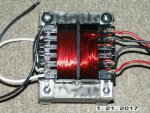Phil Corso
Senior Member
- Location
- Boca Raton, Fl, USA
Gar; Electric-Light
In general, two usual types of transformer design are dominant: a) one based on temperature-rise; b) the other based on minimum-regulation! For the latter, core and conductor elements are usually larger.
Gar has shown that his Xfmr has more iron, thus, corroborating it’s type b)! Electric-light comments list some characteristics detrimental to type b)!
When I was required to provide a quick evaluation comparing mfg’r proposals I used a Figure-Of-Merit, FoM = (wgt of Cu+Fe)/VA!
Gar, can you provide additional detail, such as: 1) primary and secondary wire-size(s); 2) whether both coils are concentrically-located on a center-limb of a 2-window, type E-core); or 3) whether both coils are separately-located on a 1-window, type C-core!
Regards, Phil Corso
In general, two usual types of transformer design are dominant: a) one based on temperature-rise; b) the other based on minimum-regulation! For the latter, core and conductor elements are usually larger.
Gar has shown that his Xfmr has more iron, thus, corroborating it’s type b)! Electric-light comments list some characteristics detrimental to type b)!
When I was required to provide a quick evaluation comparing mfg’r proposals I used a Figure-Of-Merit, FoM = (wgt of Cu+Fe)/VA!
Gar, can you provide additional detail, such as: 1) primary and secondary wire-size(s); 2) whether both coils are concentrically-located on a center-limb of a 2-window, type E-core); or 3) whether both coils are separately-located on a 1-window, type C-core!
Regards, Phil Corso
Last edited:



